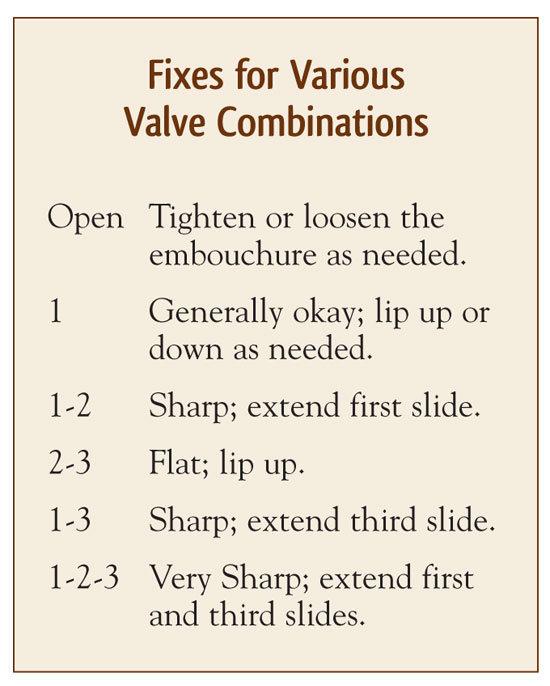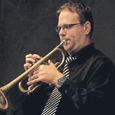It takes patience and subtlety to play with excellent intonation, but directors know that most young trumpet players lack both traits. With limited classroom time, directors may feel that refining intonation is impossible, particularly with a looming concert program every six weeks. However, the task can be less difficult that it seems, and an early dedication to a few key techniques will yield satisfying results.
.jpg)
Then and Now
About ten or fifteen years ago, manufacturers made a significant change by outfitting beginner trumpet models with both a first and third valve slide ring (the first valve slide may alternately have a U-hook). Whether in response to pleading band parents or as a gift to weary school directors, this quantum leap forward in trumpet manufacturing means every beginning students can play a fully outfitted trumpet.
I recommend retiring any trumpet in your inventory that lacks fully functioning first and third valve slides. From the very first week students play fingered notes, have them use the appropriate slides along with the fingerings. This saves teaching the concept later and allows players to begin coordinating these motions and making needed corrections in trumpet balance and hand position.
Smooth as Silk
Good left-hand technique will help players be consistent and skillful as they learn to use the valve slides properly. The left hand should remain on the valve casing when extending the first and third valve slides, whether separately or together. When extending the third slide, only the ring finger should extend and retract; for the first valve slide, only the thumb should extend. On rare occasions, young students may use the whole arm for pushing and pulling. Make sure they learn the correct technique of using only the finger or thumb.
The first and third slides should move with an easy motion. If a slide is rough or sluggish, students will develop improper technique or even stop using the slide altogether. Apply a dab of grease along with a few drops of valve oil to a clean slide. If the slide still resists, send the trumpet to a repair person. This small hassle is worth being able to play in tune.
If you have trumpeters using a marching band lyre, which is inserted in place of the third valve slide ring, have them keep the third valve slide slightly extended to avoid low D and C# being extremely sharp. Following marching season, remind players to replace the third valve slide ring and resume using it in regular playing. With some investigation it may be possible to find lyres that attach to the leadpipe, allowing the third valve slide to move.
Working with Tuners
A chromatic tuner is essential for developing perfect intonation. Students should spend time daily with this generous truth-teller. They can also practice with a tuner during sectionals to establish the habit. Players should move methodically through a series of notes, checking each note with the tuner. I like to create a game during afterschool sections to see which player can make the needle stay centered. A bit of competition builds excitement and emphasizes the value of tuning practice.
During their long-tones warm-up, students can work with a tuner to train their ear. The tuner helps students refine their sense of internal pitch. Have players work with the tuner at different dynamic levels to learn necessary adjustments at different volumes. Remind students that the tuner is only for private practice, not rehearsal. When their eyes are focused on the tuner, they will miss the opportunity to develop the most important skill of all – learning to listen to those around them.
Breathing
Excellent breath support is essential for consistent tuning. Improper breath support produces a sagging pitch and lackluster tone. Correct breathing technique from the beginning avoids many tuning problems later. A great way to learn about how breath support affects pitch is mouthpiece buzzing. Good breath support leads to buzzing a clear even note; poor support can drop the buzz to a lower pitch or make it disappear completely.
Tuning to a chromatic tuner while playing trumpet is hard enough; doing so while buzzing is even harder because the instrument isn’t guiding them to each note and stabilizing the pitch. Students should spend ten minutes a day buzzing with a tuner or matching pitches on the piano. The will improve their ears and establish muscle memory for the correct embouchure and tongue height for each note.
Listening
We want students to evaluate their tone moment by moment. When they listen carefully to what is going around them, doors start to open. Besides correcting errors, they will discover how their part makes musical sense and contributes to the larger symphonic story. One key to this discovery is listening to themselves play one note at a time in tune.
Dirty Instruments
Instruments littered with tiny debris can often be the culprit of many musical crimes. Any blockage can keep the air from flowing through the narrow pipes. Require your afternoon students to carry a travel toothbrush and use it just before practice. This will cut down on the need for cleaning during the year. Schedule a periodic instrument cleaning check in each of your ensembles to make sure students are properly caring for their instruments. For young students a monthly cleaning is best.
Bumpy Sound
Professionals use their valve slides as smoothly as professional trombone players and the slide actions seems nearly invisible. For beginning trumpeters, the use of these slide may actually make such bump that the notes almost sounds accented. Pounding of the slides can also cause the mouthpiece to rock on the embouchure, producing a fast wa-wa sound.
To remedy the problem make sure that all trumpets have their slides in perfect working order. The slide should be thrown simultaneously with the valve reaching its down-most point and retracted as soon as it is no longer needed for that particular note or line.
Often, the slide is pushed or pulled more than necessary. Take, for example, a passage that needs an extended third slide for low D (valves 1 and 3) several times. Keeping the slide extended is fine as long as the passage doesn’t contain notes fingered 2-3 (for example G# or Eb) because the slide would make these notes flat. The reduction in motion will reduce bumps in lyrical passages and is especially helpful for younger students.
Learning to Adjust
As students develop their embouchure, they can make minute adjustments that do not require using a valve slide. Notes like fourth-line D and fourth-space Eb are flat on the trumpet and cannot be corrected by extending the slide, which can only lower the pitch. For these notes students will have to lip up slightly. The chart below gives general remedies for various valve combinations.

Lip Bends
Practicing lip bends is not just for advanced players. Even younger students can benefit from these once their embouchure is fully established. By bending a pitch downward, slowly and gradually, by as much as a half to a whole step, students learn to hear the pitch center of each note and develop muscle memory to produce it. The point of the exercise is less the bending than the return to the center of the note. Have students listen for the point when they think the note is centered and in tune. Now, check their perceptions with a tuner. It gets easier with practice to find the center.
.jpg)






